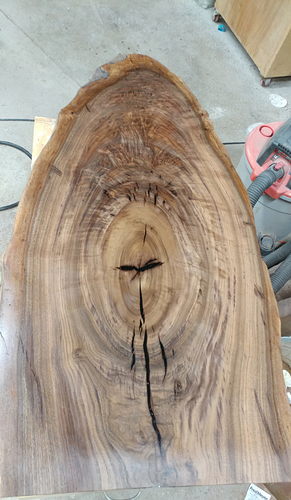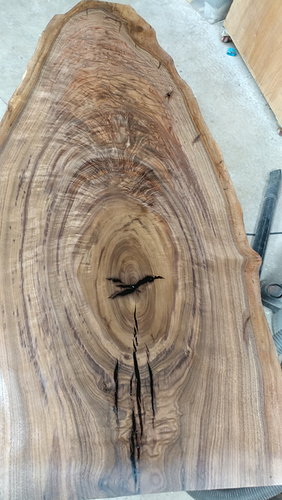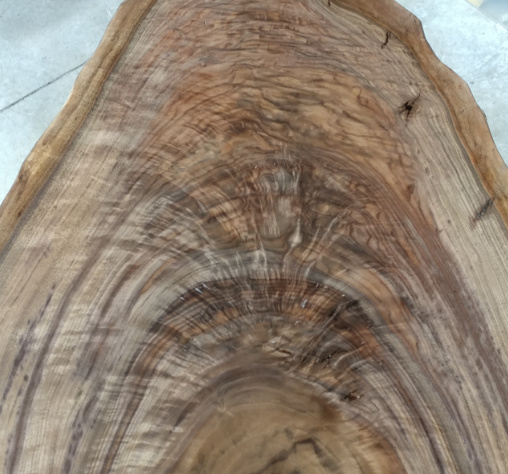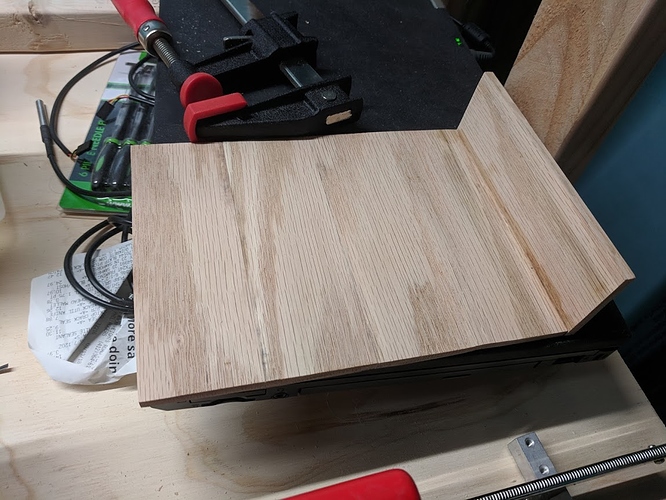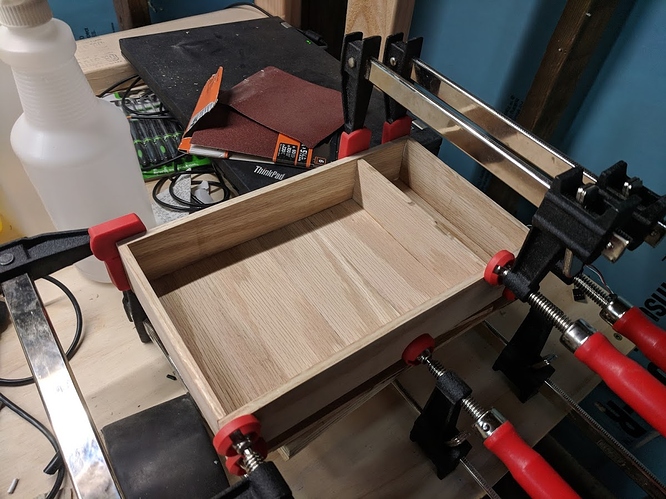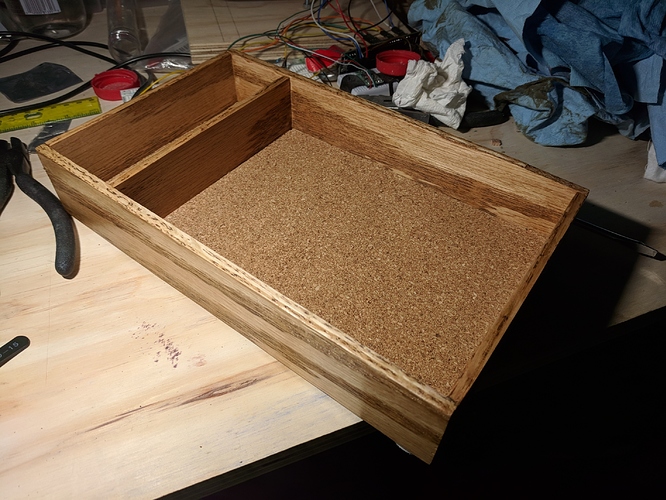Knife time! This is a Bowie that I’ve been working on for the past few weeks… It probably represents forty hours of work total, not because the craftsmanship required that, but because I’m learning-by-doing so a job that should have only take eight hours needed five times that.
Here’s a super-long post about making it. I talk a lot about metallurgy, which was my engineering specialty back in college, so I apologize up front for droning on and on about it. You can skip the text and just look at the pretty pictures if you want; I won’t be offended. I’ll collapse everything into sections to disguise the face that I’ve written a small novel here.
Drawn-out billet
Sadly, I did not get a picture of the chunk of steel that I started with. It was a slice I carved off of a heavy-duty truck’s leaf spring. It’s probably 5160 steel – meaning that it’s 0.6% carbon with about a percent each of chromium and manganese added to the iron. Tough stuff and great for knives.
Here’s the “billet” of steel after being drawn out on the pneumatic press then hammered flat. We don’t have a power-hammer, so I tend to use the press to do most of the heavy work of getting the steel thinned out, then everything else is hammer-work. I actually ended up chopping off about a third of the length because I found that I had far, far too much material. I’ll probably make a smaller knife out of that later.
Basic shaping
Next was just a lot of hammering. Drawing the blade out from the center and making the whole thing flatter. The previous pic was probably six or seven millimeters thick, but here it’s closer to 4mm all around.
The thing that I enjoy a lot about metal-shaping in general is the manipulation of the grain structure. Steel has a bunch of grains in it; you can think of them like little “cells” of metal crystals that grow in different directions until they hit one another. The heating process causes the grains to grow bigger and merge with one another, while the hammering process shatters them and makes them smaller, even as the metal moves like clay… extremely hot, dangerous clay.
So one of the things I did before this point was to hammer the billet into kind of a sickle-shape first, which compressed the grains on the inner-arc of the shape. Then when I hammered in the bevel (thinner edge) of the blade, the shape “naturally” straightened while keeping the denser grain structure. The alternative would have been to constantly heat the blade and straighten it as I worked the bevel, which in theory would have resulted in larger grains on the edge.
Scale grinding
Being largely happy with the basic shape (except the “fish lips” on the tip), I let the metal cool slowly and then took an angle-grinder to it to get rid of the forge-scale.
“Scale” is the term that we use for the black coating that forms on steel at high heat when exposed to oxygen. It’s similar to rust in that it’s oxidation, but it is a different chemical: rust is FeO(OH) while scale is Fe3O4. And while rust is fairly soft, scale is actually very hard… sometimes harder (but more brittle) than the steel underneath. It’s so tough that we tend to use angle-grinders to get rid of it rather than allowing it wear away the expensive abrasive belts that are used later.
So the pic below is basically the same as the one above, but with the scale ground off. I should probably note here that the length of the “blade” here is close to 11 inches and the length of the tang is probably close to 8".
Why do I use metric when talking about thickness and Imperial when talking about length? I dunno. I’m old and set in my ways.
Rough grinding and shaping
Now that the scale is gone, the rough grinding begins. I tend to think of this part as the “fun” grinding because you are using a super-coarse grit and you throw a lot of sparks while hogging off a vast amount of metal. It looks cool and you get immediate gratification.
The point to rough grinding is threefold: First, removing the hammer-marks and surface crap means that you can see any major cracks or imperfections in the metal itself, probably for the first time. If there is something wrong, better to catch it now. Second, it is a LOT easier to grind the metal now when it’s soft than it is after the steel is hardened, so better to grind away what you can now rather than later. And third, when you quench the steel, the metal closer to the surface will harden more than the material deeper in the piece, so you want it to be as thin as is practical.
You can’t grind it TOO thin before the final heat-treatment and quenching though, because the thinner it is during the quench, the more likely it is to warp or twist.
The other thing that you do in this step is to grind in the final shape of the knife. You can see that I’ve added a “clip” tip to the shape and straightened the spine.
Heat treating
Below is the piece after normalization and quenching. What happens here is that you heat the knife above “critical temperature” and then let it cool down to close to room temperature two or three times to “normalize” the metal, then you heat it up just past critical again and quench it in oil.
A couple terms there need some explaining: Critical temperature, normalization and quenching.
When solids are heated or subjected to extreme pressure, their crystal structure can change. The most well-known example of this is carbon: At room temperature it’s form is graphite – basically pencil lead – but at high pressure and temperature it turns transparent and hard… diamond.
Steel is like that too. At about 1600 degrees steel’s crystal structure changes: The position of the carbon atoms shift in the crystal matrix and it also becomes non-magnetic. The point where this shift takes place is called the “critical temperature” or sometimes the critical point.
Normalizing is a process where we release a lot of the stresses that have built up in the steel without increasing the grain-size too much. By heating the metal just above the critical temperature and then letting it cool down slowly, the grains don’t grow too much, but they “shift” a little and the tension between the grain boundaries slackens, which reduces the chances of cracking during the quench.
Finally the quench. As I mentioned above, solids can have different crystal structures at different temperatures and pressures. Generally when they reach a temperature they will change their structure to the one that they “want to be” at for that state. When we let the steel cool slowly in the normalizing process, it changes from the high-temperature crystal structure (austenite) to the low-temperature structure (ferrite), which is where it “wants to be”.
But we can trap a material in a crystal structure if we make the temperature and/or pressure change fast enough. Again, diamond is a good example: The diamond structure isn’t what the carbon “wants to be” at room temperature, but because the carbon was cooled so rapidly during a volcanic eruption, it has gotten “stuck” in the diamond crystal structure.
Hardened steel is like that. When we heat the steel above the critical temperature and then plunge the piece into a room-temperature liquid like oil or water, we “trap” the steel in the other crystal structure, creating a substance we call martensite.
In the pic below you can see the wonderful battleship gray color that is indicative of martensite. You might also note that the tang is mostly a darker color, indicating that it probably did not harden and remains in the softer, less brittle state (which was my intention).
Also, between the this pic and the one above, I did a little refining of the shape: I squared off the “shoulders” of the knife where the blade and the tang meet and where the guard will go, and I also tapered the tip of the tang to a thin tail. More on that later.
Main grinding
After the blade was quenched and hardened, I took it home to cook it for a while in the oven.
No, really. After it’s quenched, the metal is really hard (mine was about 53 on the Rockwell scale), but it’s also brittle: If you dropped it on concrete, there’s a non-insignificant chance it would just shatter.
So what we do is to “temper” the metal by heating it up a little and reducing the hardness a bit and giving it back a little bit of flexibility. This is done by heating the metal up to about 400 degrees F for three to four hours a couple times. Since the temperatures are so low (relatively), you can do this in a kitchen oven.
Next comes the not-as-much-fun grinding. This is where you really start to make the knife look cool, but it takes forever. You start with a low-grit grinding belt and move a lot of metal, refining the edges and adding touches like the “plunge line” and ricasso. Then you move up the grits, moving less metal each time, but making sure that you get out all the scratches from the previous belt.
In practice, you grind to a point, then see that there are some scratches that you should have gotten out two levels ago, so you go back “down” to that grit, grind them out, then retrace your steps back “up” before noticing ANOTHER scratch; rinse and repeat.
I don’t actually mind grinding that much. I find it pretty relaxing, I can listen to my audiobooks, and I only grind away a divot of flesh off my knuckles two or three times each session.
The pic below is the blade ground down to about 320 grit. The only other notable thing is that I’ve added a thread to the rat’s tail at the end of the tang. The idea was to make a threaded socket on the brass butt-cap and screw it on. That sort of happened, but not according to my plan.
Guard and butt-cap
I got some machinist’s brass off of Amazon for the guard and raided my Dad’s pantry for the handle. Dad’s a woodturner, but his eyes are always bigger than his workshop, to coin a phrase, which means that he’s got a vast storage room full of logs and chunks of exotic wood that he picked up at some show or another but just hasn’t “gotten around to” making a bowl out of.
In this case, he gave me a chunk of zebrawood, a gorgeous material with bold, alternating, warm browns.
The first piece of the wood I quickly ruined by drilling a little too far to one side when trying to make the central hole. The second piece I was far more cautious with, but it took forever to make the hole big enough using a file.
The brass was easier to work with. Brass is a soft metal that is easy to drill and file, and even easier to grind.
Originally, I wanted to take the brass to the forge and hammer it out into a more flowing shape. Sadly, the type of brass that is typically available contains an amount of lead to make it more malleable, and the head blacksmith wasn’t comfortable with the risk of lead fumes poisoning everyone, so the guard had to be shaped from the basic stock.
On the butt-cap (pommel), my original plan was to tap a screw-hole into the brass and then screw it on, locking down the guard and wooden handle. I knew my threaded section of tang was too long, but I figured I would chop some portion of it off in order to make everything fit together.
Well, my estimates were WAY off, and I ended up cutting off a good three inches or so of the tang, which included the entire threaded portion. I ended up grinding out a whole new portion, threading that, and then screwing the new one into the butt-cap. It ended up being OK because the new threaded portion was wider, which meant a better connection to the butt-cap.
I shaped the guard roughly on a little 1" belt grinder I have down in my workroom. It’s nowhere near as powerful as the 2x72 grinder we have in the maker-space, but it’s decent for little jobs. So in the picture the guard is in the “rough ground” state, as opposed to the butt-cap, which is pretty much just stock material with a threaded hole.
The blue tape, incidentally, is there for my own protection. While the blade is far from razor-sharp, it does have enough of an edge on it to cut with. In fact, any cut with the semi-sharp knife would be arguably worse, since it would be ragged. When you’re working with metal, you’ve got to take care of yourself.
Shaping the handle
More grinding! But this was grinding the wood and the brass, both of which are far more forgiving materials than steel.
I’ve only done two or three handles now, but it’s really an interesting part of the process. I’m always panicking that I’ve removed too much wood here or there, or that I’ve put the curve in the wrong place or whatever. I’m always pretty much convinced that I’ve messed everything up and that it’ll never be the shape I envisioned… and then all of a sudden it’s exactly what I had planned.
In the pic below, the wood and brass has been finished to about 400 grit or so. At that point there were a couple areas deep in the finger-welds that I couldn’t get to with the grinder easily, and I figured I would just hand-sand it from there.
An interesting aside: For the handle I made use of what’s called a “slack belt” where you use the belt grinder without a platten (metal plate) behind the belt. You move less material, but it allows the belt to kind of “flow” around the curves and gives you a better finish on curved pieces… which is pretty much the whole handle.
Anyway, using the slack belt was physically painful. The sanding process builds up a lot of static electricity, and the slack portion of the belt is just a couple inches from the metal stand that the grinder is mounted on. Every ten to twenty seconds or so, a spark would jump from my hand to the stand. It was so bad that I ended up grinding with my pinky-finger touching the stand so that I wouldn’t build up a charge.
Finished! Almost...
After nearly two and a half hours of grinding with the belt grinder, I took the knife home and spent another hour and a half hand-sanding the piece. I removed the protective tape from the knife and tried to get the finish up to about 1000 grit. I say “tried” because I just couldn’t do it. There were some deep 220-ish scratches in the blade on one side that I kept having to go back to with 320-grit sandpaper and then work back up. In the end I got a fairly-consistent 400 grit across the steel and called it a night.
The handle was easier. The wood and brass polished up pretty nicely and I was able to get most of the brass to a 1200-grit finish. Brass tarnishes fairly quickly though, so I don’t know how well it will keep the shine; I did cover it with some Tung oil (which I used on the wood), so we’ll see.
I think the grain of the wood nicely mimics the shape of the knife. I can’t claim credit for that, but I shall do so anyway.
The blade (from the guard to the tip) is just a smidge shy of ten inches. The whole thing is about 15 inches. The balance-point is just a little forward of the guard, which is about right for a Bowie, a knife often used for chopping.
Flaws: There are some smooth “divot lines” on the blade that are from me grinding too deeply with the belt and then not catching it until the hand-sanding portion. The saber-style grind (where it’s flat on top and then the bevel starts halfway down) is not even – one side is about a quarter-inch higher than the other. The whole thing is far too heavy: it should really be about a third lighter. The spine is the same thickness all the way down until about where the clip-tip starts; ideally it should have a gentle taper.
So now the next step is in my wife’s. She’s become a very skilled leather-worker and after a couple months of making patterned belts for friends and family, she’s looking forward to working with a larger “canvas”. I’ll post pics when she’s done with the sheath.


